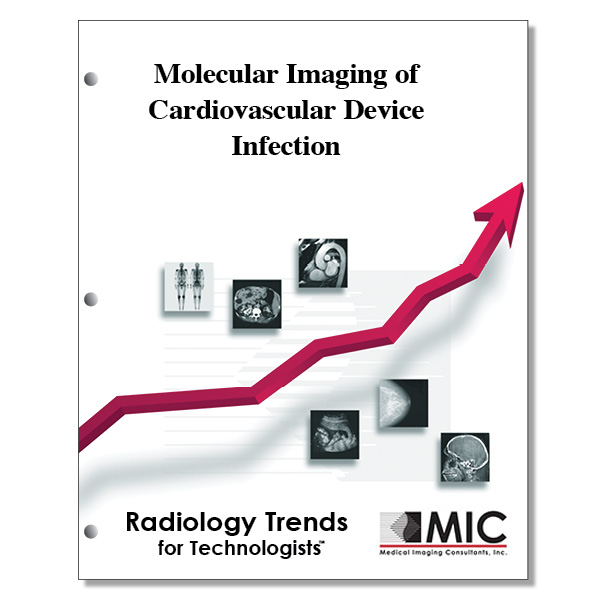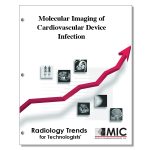

Molecular Imaging of Cardiovascular Device Infection
A presentation of the rationale for using 18F-FDG PET/CT for its unique merits over anatomic imaging to potentially diagnose early cardiac device infection.
Course ID: Q00625 Category: Radiology Trends for Technologists Modalities: Cardiac Interventional, CT, Nuclear Cardiology, Nuclear Medicine, PET, Sonography1.75 |
Satisfaction Guarantee |
$24.00
- Targeted CE
- Outline
- Objectives
Targeted CE per ARRT’s Discipline, Category, and Subcategory classification:
[Note: Discipline-specific Targeted CE credits may be less than the total Category A credits approved for this course.]
Cardiac-Interventional Radiography: 0.25
Procedures: 0.25
Diagnostic and Conduction System Studies: 0.25
Computed Tomography: 0.50
Procedures: 0.50
Neck and Chest: 0.50
Nuclear Medicine Technology: 1.75
Procedures: 1.75
Other Imaging Procedures: 1.75
Registered Radiologist Assistant: 1.75
Procedures: 1.75
Thoracic Section: 1.75
Outline
- Introduction
- Anatomic Imaging Tools
- Functional Imaging Tools
- Bacteria-Targeting Tracers
- Bacterial Metabolic Substances
- Antibiotics
- Antimicrobial Peptides
- Bacterial Antibodies
- Bacteriophages and Bacterial DNA/RNA Hybrid Nucleotide Oligomers
- Considerations of 18F-FDG and Bacteria-Targeting Tracers for Infection Imaging
- Technical Challenges for Bacteria-Targeting PET Tracers
- Bile Duct Stricture
- Conclusion
Objectives
Upon completion of this course, students will:
- be familiar with anatomically based modalities for detecting cardiovascular device infection
- be familiar with functionally based modalities for detecting cardiovascular device infection
- be familiar with the issues surrounding metal ring-related acoustic shadowing artifact on transesophageal echocardiography
- identify the imaging modalities that demonstrate late morphologic changes and have findings that are often nonspecific and associated with device related artifacts
- be familiar with how 18F-FDG PET/CT can affect the management of patients with clinically suspected endocarditis
- be familiar with the imaging modalities that have been accepted in the U.S. for detection of cardiac device infection
- be familiar with the lack of clinical translation of 99mTc-ciproflozacin as a radiotracer for detection of infection
- be familiar with 18F-labeled maltodextrin tracers being studied for infection detection
- identify the pharmacokinetic features that make 18F-maltotriose a promising radiotracer for infection imaging
- be familiar with the characteristics of 111In WBC SPECT/CT for cardiac device infection imaging
- be familiar with first line imaging modalities for infective endocarditis
- be familiar with nucleoside radiotracers for infection detection
- be familiar with the limitation of 99mTc-ciproflozacin as a radiotracer for detection of infection
- be familiar with antimicrobial peptides used for bacterial infection imaging
- be familiar with the radionuclides used to label antimicrobial peptides for infection imaging
- recognize the limitations of radiolabeled antibodies for bacterial infection imaging
- identify organizations recommending 18F-FDG PET/CT for diagnosis of cardiac device-related and prosthetic valve endocarditis
- be familiar with methods to address nonspecific accumulation of 18F FDG PET/CT
- be familiar with the limited use of 18F-FDG PET/CT for cardiac device infection in the U.S.
- understand what a negative18F-FDG PET/CT represents in patients with suspected cardiac device infection
- understand the effects of antibiotics on bacterial radiotracer imaging
- be familiar with the method of excretion for 18F-maltose
- be familiar with the MDT radiotracer that holds the most promise for imaging infection in a clinical setting
- identify the target of 18F-FDG PET/CT imaging
- be familiar with the radiotracers for infection imaging studied in humans
- identify the bacterial radiotracers that target DNA gyrase
- be familiar with the main findings surrounding studies conducted with antimicrobial peptides
- be familiar with the biofilm formation associated with cardiac device infection
- recognize the reasons for lower sensitivity found in the use of most bacterial radiotracers
- be familiar with the use 18F-FDG PET/CT in detecting cardiac device infection
